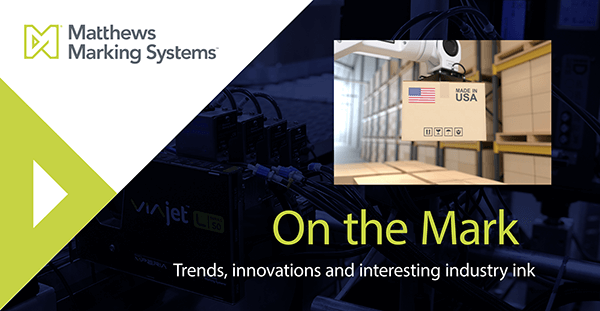Marking as a Marketing Tool, Reshoring the Metal Industry, and ERP for SMB

Catching up on interesting news and innovations in production, packaging and more
The “4 Ps” of marketing are no longer enough to present your brand in the best light
Just ask anyone in your marketing department what the “4 Ps” are, and they’ll probably tell you: Product, Price, Place and Promotion – but that’s no longer enough to succeed in today’s fast-changing, highly competitive markets. Marketing expert Gino Biondi expands on the Ps of marketing for Building Products Digest, extending it to a long list of 13 (we admire his alliteration skills). Among them, one really stood out to us (of course): Packaging, which he describes as “the most impactful marketing tool.”
While we agree that all of the Ps are important in marketing your building products (or any product, for that matter), packaging is an often overlooked subject, and we’ve been talking about it for a long time. That’s because high quality product marking and labeling are essential to reap the benefits of packaging as a marketing asset.
Quite simply, the quality of your marks, whether printed directly on your product or on its packaging, has an impact – positive or negative – on how your brand is perceived by your supply chain partners, retailers and end customers.
“Quality has an emotional response – sloppy fit and finish or crooked labels say a lot about the brand,” says Biondi. “Graphics need to be compelling – authentic, modern, innovative, nostalgic, youthful, serious, fun.”
Source: Building Products Digest.
On the Mark:
Whether you’re marking on wood, metal, rubber, plastic, bags, boxes, or pallets, the quality of your marks matters. In addition to branding, mark quality is important for traceability – a smeared, unreadable mark or a poorly adhered barcode label that falls off can result in your product being improperly shipped, held, stocked, priced or lost entirely in the supply chain.
Reshoring is a boon to the metal industry
Driven largely by government incentives for rebuilding domestic manufacturing and expanded local supply chains, “reshoring” – bringing industries back to the U.S. after years of being outsourced to other countries – is having a positive impact on revenues for the metalcasting industry.
The AFS 2023 Metalcasting Forecast and Trends Midyear Report, published in July, projects a 6.6% increase in casting sales for the year, and 2022 revenue indicates a 12.5% year over year growth – the second consecutive year of double-digit growth.
“For metalcasters riding this wave, reinvesting will be critical to match the growing demand for domestic manufacturing,” says Modern Casting columnist Shannon Wetzel.
In addition to eco-system synergies (i.e. healthy local supply chains) and government incentives, the other projected top factors for reshoring are proximity to customers/market, skilled workforce availability/training, infrastructure, impact on domestic economy, manufacturing/engineering joint innovation (R&D) and…drumroll please… Image/Made in USA brand.
Source: moderncasting.com.
On the Mark:
Metals are among the toughest materials on which to get clean, durable, reliable marks. That’s because metal manufacturing facilities place incredible demands on marking systems, with high temperatures, oily and dusty surfaces and variable material compositions that often require special inks. That’s why we make printers that are designed specifically for operation in harsh environments with minimal maintenance and inks that are perfectly matched to the substrate to ensure that your Made in USA and other marks and codes are clearly readable as your products move through the supply chain.
Use of ERP software is on the rise for small- and medium-sized food and beverage companies
Once upon a time (and for a long time) only the largest global companies had the deep pockets required to purchase and implement ERP systems. That’s no longer the case, according to ProFoodWorld. ERP software and tools are becoming more powerful, more widely available, more industry-targeted and less expensive, as ERP vendors embrace the opportunity to meet the needs of small and medium-sized businesses with ERP tools that enable more efficient business management.
ERPs provide supply chain management, manufacturing execution and end-to-end visibility of operations across the enterprise. Interconnectivity is also key for food and beverage companies, and they’re connecting ERP systems with other software for things like real-time inventory tracking, in-depth reporting and analytics, warehouse management systems, and technology that supports track-and-trace and FDA regulatory compliance functions. These API-driven connections enable small and medium-sized companies to create more streamlined workflows and get more from their back-end systems.
“It was not long ago that using sophisticated software meant you had to be a large company with deep pockets. That’s not true today as software has become both more powerful and less expensive, putting it within reach of small and medium-sized companies as well,” says manufacturing automation writer Jeanne Schweder.
Source: profoodworld.com.
On the Mark:
Marking automation offers a number of advantages we won’t unpack here (please see Boost Efficiency with Marking Automation), but we will say that if you want to get the most from your ERP, you’ll want to invest in marking equipment that can be fully integrated. To do this, you’ll need a centralized controller, such as the MPERIA platform, that enables you to manage all of your printers, labelers, vision systems and coders from one location AND integrates seamlessly with your ERP (without requiring expensive custom code and maintenance). The right controller, one that shares information securely with your ERP system, will give you unparalleled control and visibility across your marking operations.
Want to make Your Mark?
What captured your attention in the news recently?
We want to share news that is important to our readers. Submit an industry news article that you found thought-provoking to [email protected], and we’ll consider adding it to an upcoming issue of On the Mark!
